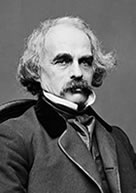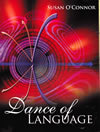Nathaniel Hawthorne
 Nathaniel Hawthorne, nineteenth century author of short stories, novels, and essays, is the leading writer of
fiction of the American Renaissance. He combined his strong interest in the seventeenth century Puritans of New England
with his own experiences with family and society to produce what many scholars believe to be the best American
fiction writer of that time. Because Hawthorne’s life was filled with isolation, rejection, mystery, and a great-great grandfather
who presided over the Salem witch trials, his writing in stories such as “Young Goodman Brown” and
The Scarlet Letter often appears dark and gloomy. Yet in every piece of Hawthorne’s fiction, the reader comes away with the sense that a state of balance,
a major theme in his work, has been produced in either the plot or the moral of the story.
Nathaniel Hawthorne, nineteenth century author of short stories, novels, and essays, is the leading writer of
fiction of the American Renaissance. He combined his strong interest in the seventeenth century Puritans of New England
with his own experiences with family and society to produce what many scholars believe to be the best American
fiction writer of that time. Because Hawthorne’s life was filled with isolation, rejection, mystery, and a great-great grandfather
who presided over the Salem witch trials, his writing in stories such as “Young Goodman Brown” and
The Scarlet Letter often appears dark and gloomy. Yet in every piece of Hawthorne’s fiction, the reader comes away with the sense that a state of balance,
a major theme in his work, has been produced in either the plot or the moral of the story.
 Hawthorne was a master of symbolism and figurative language, adding even greater depth and beauty to the language and meaning of the work.
Reading and analyzing a number of pieces by this author can produce greater sensitivity to the elements of fiction he uses so well.
The student of Hawthorne who understands archetypes and motifs, the theme of balance that runs through an entire body of work, the uses of irony,
and the imagery produced by figurative language will feel more prepared to approach other more sophisticated literature with less trepidation.
Hawthorne was a master of symbolism and figurative language, adding even greater depth and beauty to the language and meaning of the work.
Reading and analyzing a number of pieces by this author can produce greater sensitivity to the elements of fiction he uses so well.
The student of Hawthorne who understands archetypes and motifs, the theme of balance that runs through an entire body of work, the uses of irony,
and the imagery produced by figurative language will feel more prepared to approach other more sophisticated literature with less trepidation.
